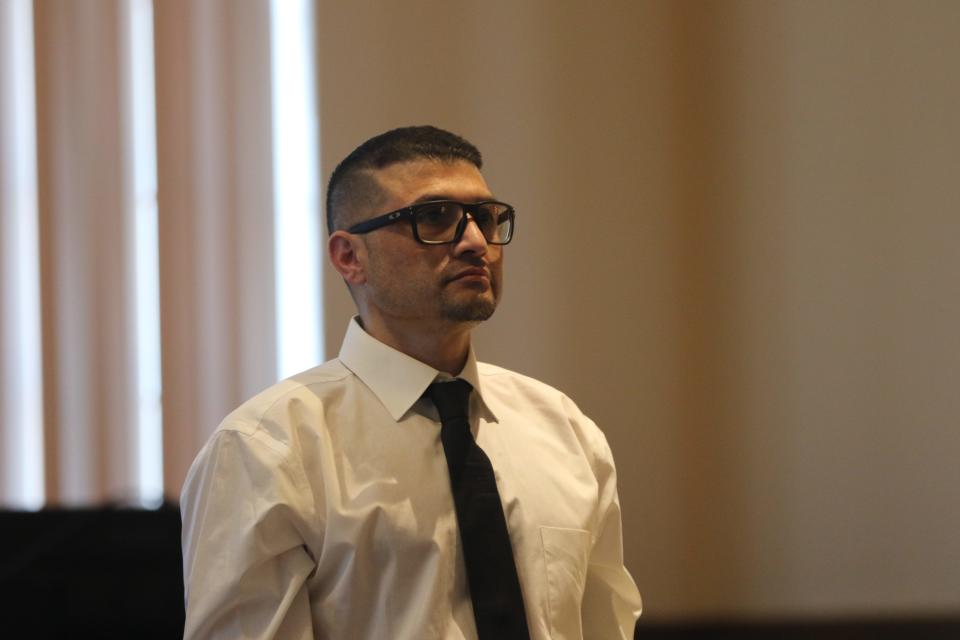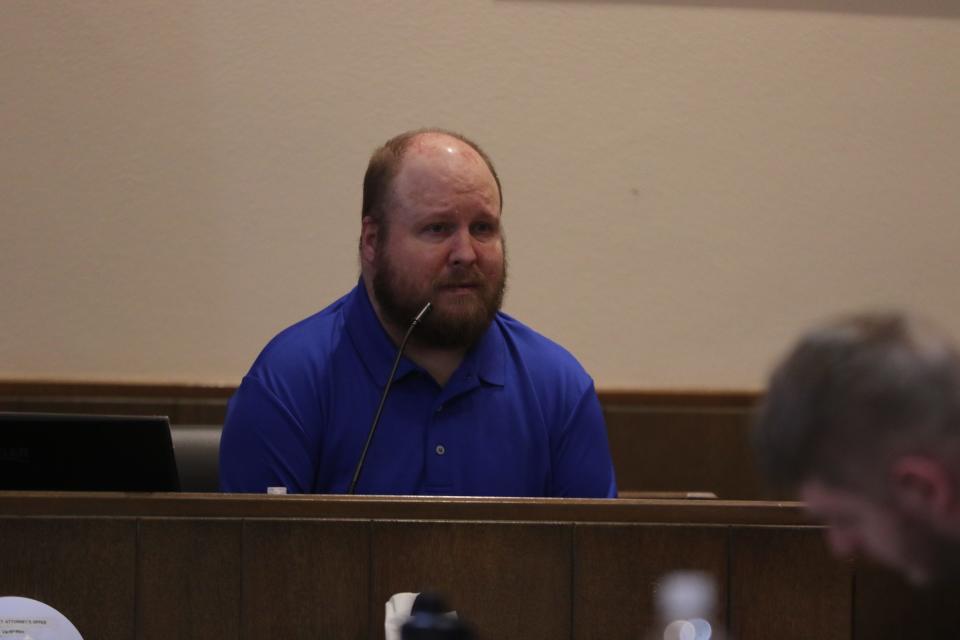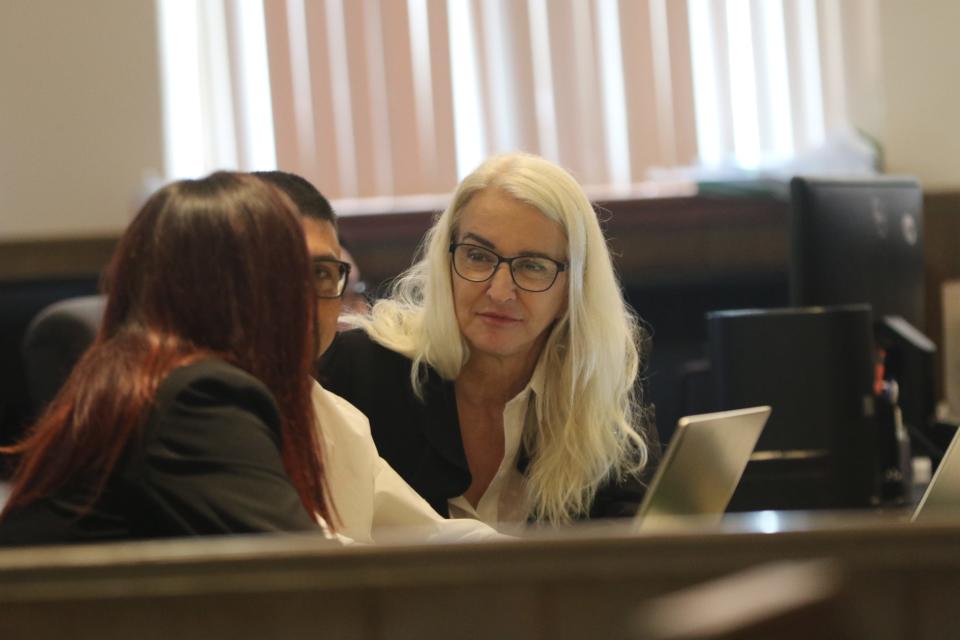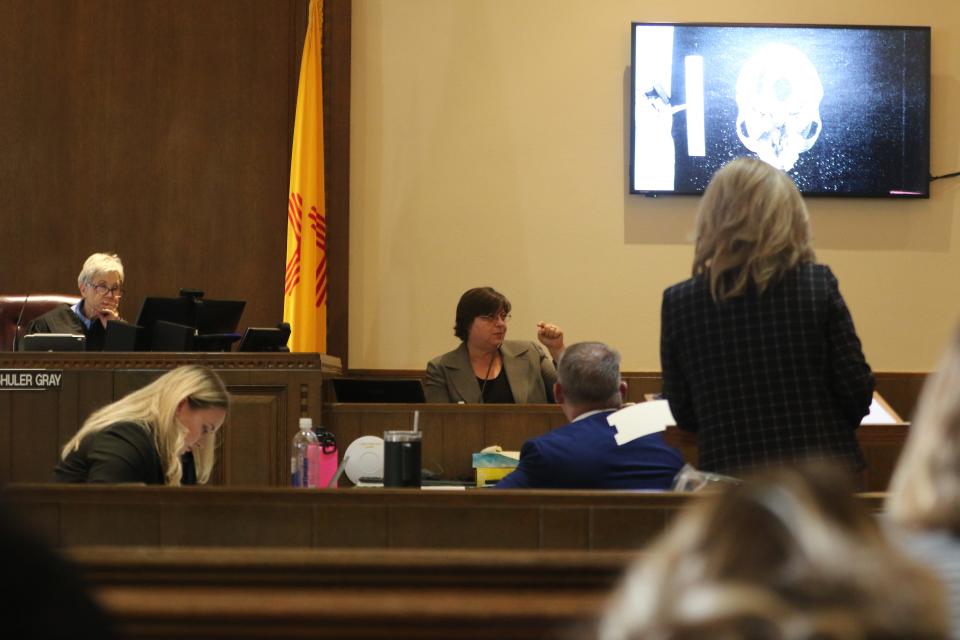'Manny walks in and shoots Brian,' says man testifying in Manuel Sanchez murder trial
- Oops!Something went wrong.Please try again later.
Brett Roark took the witness stand Wednesday, nine years after the night he said Brian Runnels was murdered by Manuel Sanchez.
His testimony came on the third day of Sanchez’s trial on a charge of first-degree murder and one charge of tampering with evidence.
Roark faces the same charges after he confessed to helping Sanchez bury the body on the night of the murder in October 2014.
More: Manuel Sanchez's attorneys question evidence linking him to Brian Runnels' 2014 murder

Roark's trial is scheduled for February 2024.
Much of the third day of the trial in Carlsbad Fifth Judicial District Court, aside from Roark’s testimony, saw forensic experts explain how Runnels’ skeletal remains were unearthed, studied and ultimately identified.
They also described for the 12-person jury multiple injuries the bones apparently suffered before or after death.
Here’s what happened on the third day of Manuel Sanchez’s murder trial.
More: Murder trial begins for Manuel Sanchez, accused of killing Carlsbad man missing for 6 years
‘I was scared Manny would kill me,’ says man who accused Sanchez of murder
At the stand, Roark was asked by the prosecution to explain the events leading up to Runnels’ death allegedly at the hands of Sanchez and how he ordered Roark to help bury the body.
He said he was working for the property owner Thomas “Ace” Appling in 2014 and had worked for him on and off in the past, frequently staying the night.
Roark declined to identify Sanchez in the court room, telling prosecutors he didn’t remember what he looked like, but maintained that Sanchez was the lone shooter of Runnels.
More: Trial for man accused of killing missing Carlsbad man starts Monday. Here's what to know.
That night on Oct. 17, 2014, Roark said when questioned by the State that he saw Runnels come to the main house on the property to eat.
Later that night, Roark said Sanchez led him to Runnels’ camper on the property where the victim lived. That’s where he said Sanchez shot into the trailer with a high-powered rifle, hitting Runnels in the chest and killing him.
“Manny walks in and shoots Brian,” Roark said. “Brian hit the ground. My head’s just racing. What am I going to do? I did what he (Sanchez) told me to do. I helped him.”
More: Alexis Murray Smith guilty of child abuse in son Brent Sullivan's fentanyl overdose death

He said Sanchez used chemicals to clean up the blood and pulled up the carpet in the camper.
Next, Roark said he helped Sanchez load Runnels’ body onto a Kubota utility vehicle, and they drove out to a remote area off the property, and buried him along with the sheet they wrapped Runnels in.
Before burying the body, Roark said Sanchez hit Runnels, now deceased, in the side of his head with a shovel.
"He didn’t tell me anything. He didn’t tell me why," Roark said. “He just said he’d kill me if I told anybody or if I didn’t help him. I was scared Manny would kill me."
More: New Mexico State Police Officer Sam Clouthier charged with possession of child pornography
Defense looks to discredit Roark as his story contradicts past statements
Defense Attorney Lisa Torraco looked to poke holes in Roark’s testimony, pointing to previous statements he’d make to law enforcement and others that contradicted the version he gave from the witness stand.
Torraco posited Carlsbad Police Detective Tim Nyce and other officers used “deceptive tactics” to coax Roark to confess and implicate Sanchez in the murder.
It was Nyce who first mentioned Sanchez to Roark, Torraco said, after developing a rapport with the witness.
“He said you were a good guy, but he said he wasn’t sure about Manny,” Torraco said, referencing a recorded interview. “He brought Manny up. That’s when you started talking about Manny.”
More: Jury says not guilty in fatal 2021 shooting near Carlsbad playground

She also contended Roark only mentioned the shovel strike, which lined up with a fracture found on Runnels skull, after the autopsy report was available and at Nyce’s suggestion.
Torraco pointed out to the jury that Roark initially denied helping Sanchez at all, then confessed to his role only after several police interviews.
Other details of Roark’s account changed through multiple interviews, Torraco alleged, such as what happened to the carpet Roark said was removed from the camper after the shooting or if Sanchez actually went inside Runnels trailer the night he died.
Roark agreed when Torraco suggested that he “didn’t know anything about the clean-up,” and that he was “just guessing” in past statements.
More: Carlsbad couple get decades in prison for filming child porn at home, posting online
Recovery of Runnels’ remains detailed by witness
Pictures of Runnels’ skull, ribs and other bones were projected in the courtroom for the jury to see, drawing emotional reactions from the family of the victim.
Many left the room during the display, and other dabbed at their tears with tissues.
Rick Wiedenmann, a local field investigator with the Office of the Medical Examiner described how the skeletal remains were exhumed from the shallow grave allegedly dug by Roark and Sanchez the night of Runnels’ death.
“We recovered almost an entire skeleton,” Wiedenmann said.
More: Man accused of stealing wife's search and rescue dogs now charged with plotting her murder
Victim suffered ‘blunt force trauma,’ autopsy shows
The autopsy of Runnels’ bones was explained to the jury by Heather Jarrell, the chief medical investigator at the New Mexico Office of the Medical Investigator (OMI).
She noted several factures to the skull and facial area, and said the OMI determined the cause of death as “homicide by unspecified means,” meaning someone killed Runnels but it was unclear how.
Jarrell did say investigators found evidence of “blunt force trauma” to the head and face, but no direct evidence of any gunshot wounds.
More: Bandidos raids in New Mexico stem from 'all-out war' between motorcycle clubs, police say
She said gunshot wounds to the body could not be ruled out or confirmed, just that no evidence was found in the remains provided to the laboratory.
A gunshot wound could have been suffered to a fleshy part of the body, or an internal organ, Jarrell said, but there was none of that tissue left when the OMI received the bones.
“Fractures are essentially occurring because of blunt force trauma,” she said. “I cannot say for certain that there wasn’t a gunshot wound.”
More: Lubbock woman pleads guilty, admits to bringing girl to Carlsbad for prostitution

Medical experts say fractures were caused by ‘significant force’
Without any soft tissue left on the body, Jarrell said it was impossible to tell if there was or wasn’t a cause of death other than the trauma.
Gunshot wounds typically cause beveling when they impact bones, Jarrell said, and it was not observed on the bones provided.
“There are certain ways that bone fractures when shot,” she said. “Because there was no skin, there was a lack of flesh and organ, you can’t tell if there was another cause other than blunt force trauma.”
More: Artesia police officer on leave after shooting man police said shot and killed another
Jarrell did say the wounds would require “significant force,” that there was no bullet found at the scene and that there was no way of telling if the fractures were made by multiple impacts or just one.
Similar testimony was given by OMI forensic anthropologist Heather Edgar who described how the office determined the approximate age, gender, height and ethnicity of the bones, and noted the fractures occurred soon before or after the time of death.
She said the fractures were likely made with a weapon, contending a shovel as Roark said was just as likely as a baseball bat or rock.
“This is a lot of force,” she said. “It’s challenging for me to imagine a punch causing this much damage.”
What’s next?
Brett Roark, who blamed Sanchez for shooting Runnels, will continue his testimony into the fourth day of the trial on Thursday.
Lead Detective Tim Nyce is still yet to be called to testify, and the defense will be allowed to call witnesses after the State’s case rests.
The prosecution will likely make closing arguments after evidence from both sides is presented, and the defense will also have an opportunity to do so.
The 12-person jury will then deliberate and a verdict was expected by Friday.
Adrian Hedden can be reached at 575-628-5516, achedden@currentargus.com or @AdrianHedden on X, formerly known as Twitter.
This article originally appeared on Carlsbad Current-Argus: Brett Roark testifies he watched Manuel Sanchez murder Brian Runnels

